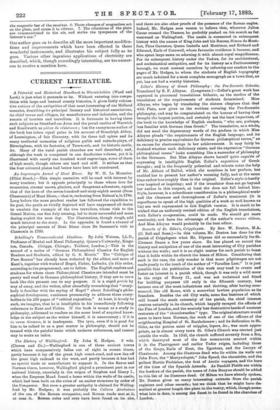Records of St. Giles's, Gripplegate. By Rev. W. Denton, MA.
(G. Bell and Sons.)—In this volume, Mr. Denton has done for the parish of Cripplegate what Mr. Diprose did so successfully for St. Clement Danes a few years since. He has placed on record the history and antiquities of one of the most interesting of City parishes without the walls ; and it is no.slight matter for such parish to boast that it holds within its church the bones of Milton. Considering that each is the case, the only wonder is that more pilgrimages are not made yearly to the tomb of the author of "Paradise Lost." It is just possible that the publication of this work may tend to create and foster an interest in a parish which, though it was only a wild moor in the reign of Henry II., and was not reclaimed and fitted for building purposes till early in the fifteenth century, has. become one of the most. industrious and thriving, after having °ern.. menced, like old Rome, with a somewhat lawless population as its founders. Besides the old City walls, some fine bastions of which still bound the south extremity of the pariah, the chief interest centres naturally in its church, which happily escaped the effects of the Fire of London, and the scarcely less destructive hands of amateur restorers of the "churchwarden" type. The original structure would seem to have been Norman, the work of one of the officers of the, neighbouring Hospital of St. Bartholomew ; and its dedication to St. Giles, as the patron saint of cripples, lepers, etc., was most appro- priate, as in almost every town St. Giles's Church was erected just outside the walla. In 1545, the church suffered severely from a fire, which destroyed most of the fine monuments erected within it in the Plantagenet and earlier Tudor reigns, including those of the Greys, Earls of Kent, the Egertons, and the Luceys of Charlecote. Among the illastrous dead who lie within its walls are John Foxe, the " Martyrologist," John Speed, the chronicler, and the gallant Martin Frobisher, the first of Arctic voyagers, and the hero of the time of the Spanish Armada. As Bunhill Fields are within the borders of the parish, the name of John Bunyan should be added to this list of its illustrons dead. Of Milton we have already spoken. Mr. Denton gives us many interesting extracts from the parish registers and other records ; but we think that he might have de- scribed at greater length the plate in the vestry, which, though some- what late in date, is among the finest to be fund in the churches of London.














































 Previous page
Previous page